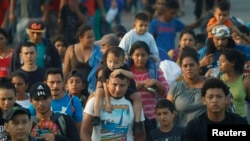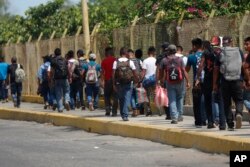VOA's Masood Farivar and Eugenia Sagastume contributed to this report.
The Trump administration hopes within days to conclude a deal with Guatemala that would block Central Americans from seeking asylum in the U.S.
VOA has obtained an unsigned copy of a seven-page draft White House agreement which would establish a "safe third country" protocol between the U.S. and Guatemala. The draft is set to be presented to the government in Guatemala City this week.
Under the terms of the agreement, migrants fleeing persecution in El Salvador and Honduras would be required to seek asylum in Guatemala, a gateway to Mexico and the United States. With few exceptions, those who continue north to the U.S. without testing their chances in Guatemala would be sent back to Guatemala by U.S. immigration authorities.
Mexico has resisted entering a "safe third country" agreement as part of its recent deal with the Trump administration to avoid punishing tariffs. But talks of a regional pact emerged shortly after President Donald Trump revealed he had agreed to terms with Mexico to curb migration levels through increased Mexican enforcement.
In May, U.S. Customs and Border Protection (CBP) registered the highest monthly total of southwest border apprehensions in 13 years, setting up Trump's most recent showdown with his Mexican counterparts.
Under the agreement that staved off U.S. tariffs, Mexico pledged to deploy 6,000 National Guard troops along its southern border with Guatemala and increase its arrests of Central American migrants headed north. Mexico also agreed to an expansion of the United States' "Remain in Mexico" policy — or Migrant Protection Protocol — which requires migrants seeking asylum in the U.S. to wait in Mexico pending a decision on their claims.
The pending agreement with Guatemala, if signed, would be the first such agreement with a Latin American country in U.S. history. In response to written questions about the draft agreement, a State Department spokesperson for Western Hemisphere Affairs told VOA Thursday that "The U.S. team currently in Guatemala is working with Guatemalan counterparts to explore a full range of initiatives to advance this agenda, including capacity building, strengthening of local institutions, and improved asylum processing," adding, "We will not disclose further details of ongoing, private diplomatic conversations."
U.S. delegation in Guatemala
Hugo Rodriguez, Deputy Assistant Secretary for Central America of the Bureau of Western Hemisphere Affairs; Carol Thompson O'Connell, Principal Deputy Assistant Secretary of the Bureau of Population, Refugees and Migration; and a legal adviser were in Guatemala on Thursday as part of a U.S. State Department delegation, according to a State Department official who declined to be identified.
The White House finalized the draft agreement Monday, according to the source, and the agreement was expected to be presented to Guatemala officials as early as Thursday — three days before a first round of presidential elections in that country.
However, there are differences of opinion within the State Department over the merits of the agreement, according to the State Department official. The official said U.S. Secretary of State Mike Pompeo directed the negotiators to travel with a slimmed down delegation in order to keep a low profile so close to the balloting.
If no candidate receives more than 50% of the vote on Sunday, there will be a second round of voting in August. Guatemala's current president, Jimmy Morales, is constitutionally prohibited from running for a second term.
The White House did not respond to VOA questions about the proposed agreement, including the prospects of Guatemala signing the pact and the thinking behind the timing. VOA has reached out to the Guatemalian government for comment and is awaiting a response.
Regional asylum agreement
While the outreach to Guatemala has not been made public, the idea of a regional asylum agreement has been floated by international policy makers.
On Monday, Vice President Mike Pence told Fox News that the administration had reached an agreement with Guatemala "to essentially say that if people are looking for asylum, that they ought to be willing to apply for asylum in the first safe country in which they arrive." He added: "We will only move onto that if it's necessary."
Also Monday, Mexican Foreign Minister Marcelo Ebrard said Mexican officials — who have long resisted the idea of a U.S.-Mexico "safe third country" agreement — would consider changing asylum rules after a 45-day review period. But that would only be under the conditions that "it will have to be regional," presented to Congress, and coordinated with the U.N. High Commissioner for Refugees.
Ebrard suggested that any such regional model might include Guatemala, Panama and Brazil.
The U.S. has only one existing "safe third country" agreement, and that's with Canada, signed in 2002. Under that agreement, both countries are deemed safe for refugee claimants, who are "required to request refugee protection in the first safe country they arrive in," with few exceptions, including unaccompanied minors.
If a similar agreement were reached with the Guatemalan government, refugees fleeing persecution from neighboring Central American countries might have no choice but to test their asylum chances in Guatemala. If Panama and Brazil followed suit, a collective responsibility would be shared: An African or Indian migrant who makes it to Brazil might have to seek asylum there. Venezuelans might test their chances there or in Panama.
In a Wednesday press release, UNHCR urged regional officials "to map out coordinated action" to address growing displacement, and signalled that a regional approach would need to include "expansion of reception capacity and asylum infrastructures, collective support for local integration programs, expanded resettlement within and outside the region and arrangements for safe and dignified return of people not needing international protection."
Danger to migrants
Guatemala — a country plagued by extreme poverty — may have incentive to accept U.S. terms for a "safe third country" agreement. In March, the Trump administration announced a cut-off in aid to Guatemala, Honduras and El Salvador in retaliation for the ongoing migrant crisis on the U.S. southern border.
How Guatemala's outgoing president precisely benefits from signing the "safe third" agreement remains unclear. At the end of the day, social consequences may be outweighed by its need to cooperate with U.S. geostrategic goals, says Giulio Talamonti, a security and political analyst and professor at Mariano Gálvez University in Guatemala City.
"Surely, the only option left for Guatemala, as a small nation in the concert of nations, will be to accept those terms and conditions," Talamonti told VOA's Latin America Division, adding that problems resulting from migration will be transferred to the new Guatemalan government independent of who wins the presidential election.
Politically, the Guatemalan government may only stand to lose more if Morales doesn't sign.
"I'm not sure Guatemala would gain anything other than to remain in the [U.S. government's] good graces on the regional migration issue, which is a major objective of the current Guatemalan government that leaves office in seven months," retired U.S. Ambassador to Guatemala Stephen McFarland told VOA.
Eleanor Acer, director of Human Rights First's Refugee Protection program, says the asylum systems in both Mexico and Guatemala are riddled with deficiencies, and argues the U.S. should be doing more to strengthen the region's ability to host more refugees.
"Often, refugees face very real dangers in neighboring countries," Acer told VOA. "They could be at serious risk of being returned to persecution, or their persecutors in some cases can actually reach them in neighboring countries. This is a very real concern."







